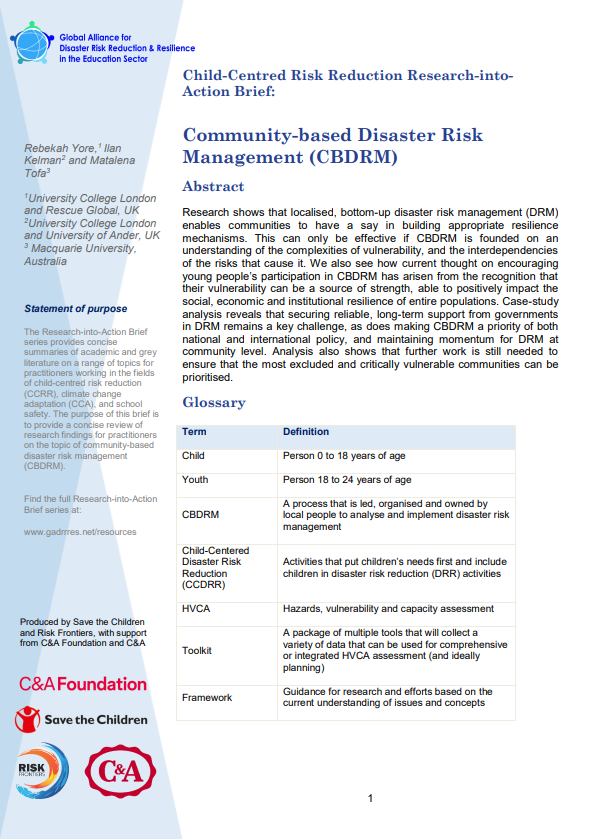
Briefs, Fact Sheets and Brochures
Research-into-Action Brief: Community-based Disaster Risk Management (CBDRM)
Publication year:
2018
English, Hindi
Format:
pdf (333.0 KiB)
Publisher:
GADRRRES, Global Alliance for Disaster Risk Reduction and Resilience in the Education Sector
This brief highlights how localised, bottom-up disaster risk management (DRM) enables communities to have a say in building appropriate resilience mechanisms. This can only be effective if Community-Based Disaster Risk Management (CBDRM) is founded on an understanding of the complexities of vulnerability, and the interdependencies of the risks that cause it. Current thought on encouraging young people’s participation in CBDRM has arisen from the recognition that their vulnerability can be a source of strength, able to positively impact the social, economic and institutional resilience of entire populations. Case-study analysis reveals that securing reliable, long-term support from governments in DRM remains a key challenge, as does making CBDRM a priority of both national and international policy and maintaining momentum for DRM at community level. Analysis also shows that further work is still needed to ensure that the most excluded and critically vulnerable communities can be prioritised. This brief is part of a series.
The Research-into-Action Brief series includes two main tools:
1. Research-into-Action Briefs and Summaries
2. Shared Bibliography on Zotero: https://www.zotero.org/groups/1857446/ccrr__css
These tools are for practitioners working in fields of child-centred risk reduction (CCRR), climate change adaptation (CCA) and school safety. The briefs and summaries are also intended to be used for training and capacity development for practitioners and partners, including government.
The briefs provide a concise review of research findings on a range of topics which have been selected by practitioners. The briefs have a focus on how the research findings could be (or have been) applied in practice. Each brief is 6-10 pages long, and generally contains a glossary, literature review, case study or examples, practical applications, key readings, and follow-up questions. The summaries are two pages long and provide a quick snapshot of the main messages from the briefs. These can be used to both promote the full Research-into-Action Brief, to provide a quick overview of the topic, or to promote the use of research.
Read full abstract
Authors
View & Download
Autodetected language
English
3 Documents
Other languages
Document information
Publisher
Authors
Format
Content type
Rights
© Author/Publisher
Found a mistake? Help us improve!
If you have noticed a document assigned to the wrong author or any other inaccuracies, let us know! Your feedback helps us keep our data accurate and useful for everyone.
Share
Link
